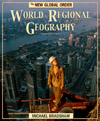 |  World Regional Geography: The New Global Order Update, 2/e Michael Bradshaw,
College of St. Mark and John
Basics of World Regional Geography
Chapter ObjectivesAfter reading and studying this chapter you should be able to:
| 1. Understand the numerous aspects and issues involved in studying world regional geography. |
 |  |  | | 2. Describe how geographers obtain information and how they analyze a given
issue. |
 |  |  | | 3. Locate places using latitude and longitude. |
 |  |  | | 4. Know the differences between small-scale and large-scale maps. |
 |  |  | | 5. Explain why some areas contain very few people and other areas have very
large populations. |
 |  |  | | 6. Define important demographic concepts and terms. |
 |  |  | | 7. Use the United Kingdom to explain the difference between a nation and a
country. |
 |  |  | | 8. Give examples of businesses in each of the primary, secondary, tertiary,
and quaternary sectors. |
 |  |  | | 9. Describe how multinational corporations operate around the world. |
 |  |  | | 10. Outline the characteristics of global cities. |
 |  |  | | 11. Discuss development including what it is, why it is uneven, and how it is
measured. |
 |  |  | | 12. Distinguish between the different processes or theories of development. |
 |  |  | | 13. Understand the roles of language and religion within a culture. |
 |  |  | | 14. Distinguish between race, class, and gender. |
 |  |  | | 15. List the different aspects that make up the natural environment. |
 |  |  | | 16. Understand concepts related to climate and shaping the land surface. |
 |  |  | | 17. Compare and contrast the major biomes of the world. |
 |  |  | | 18. Describe the effects that resources and natural hazards have on people in
different regions. |
 |  |  | | 20. Provide examples of human impacts on the environment. |
|



 2002 McGraw-Hill Higher Education
2002 McGraw-Hill Higher Education